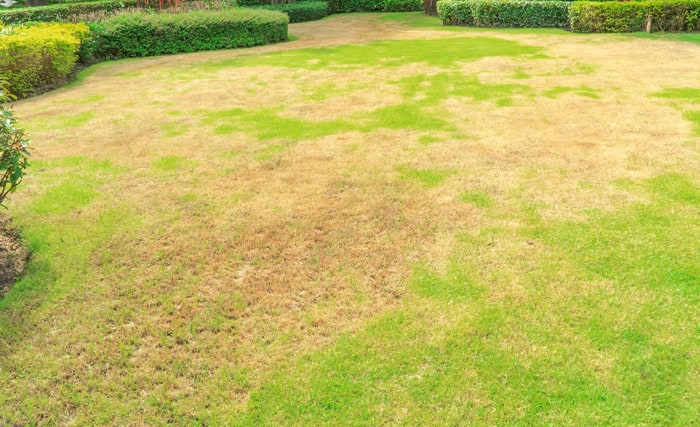How to Patch Your Lawn.
Get rid of dead spots and damage from pets and lawn traffic.
Despite our best efforts, some lawns still develop patchy spots of dead or missing grass. Not only is this an eyesore, but recurring issues can leave you with an unhealthy lawn that is riddled with insects and other pests. Luckily, the process of patching and filling in these bald spots is a lot easier than it might seem.
Finding Out What Went Wrong
Start by trying to diagnose the underlying cause of the problem. There could be numerous different reasons for a dying or patchy lawn, from overly compacted soil to insects and even issues with shade. If you don’t address the root cause, you’ll likely experience the same problems in the future.
Preparing Your Lawn
Now it’s time to prepare your lawn for the task at hand. The process is the same whether you choose seed or sod, so you don’t even have to make your decision yet – we’ll do that in the next step.
First, remove all the remaining grass from the affected area. This is easily achieved by making a rough outline around the area with a spade or shovel. For best results, make sure your outline extends past the problem area so you’re sure to remove it completely.
Once your outline is complete, proceed by removing the topmost layer of your lawn, including the soil underneath. Try to dig at least four inches into the soil within the outline, as this will immediately help with any soil compaction issues. It also makes it easier for the roots of your grass seed to take hold – if that’s the route you choose.
Enriching the Soil
While this is an optional step, enriching the soil with fertilizer, compost, or other organic matter can greatly improve the condition of your entire lawn. There are many different techniques to use for soil enrichment, so feel free to use your preferred method.
Sowing Grass Seed
If you plan on filling in your patchy lawn with grass seed, now is the time to begin. Smaller areas can be seeded by hand, but larger areas might require a spreader. Regardless, make sure to pick a type of grass seed that works best in your region and climate. Certain types are more difficult to grow in specific regions than others, so you’re only complicating the issue and setting yourself up for failure by picking the wrong grass seed.
Using Sod
Laying sod is a popular alternative to seeding. This is especially useful when you need to patch your lawn as quickly as possible, as you won’t have to wait for the grass to grow before you can see the results.
You can use the shovel or spade you used earlier to cut the replacement sod to size. Next, place your newly cut sod over the patch and knead the edges into the surrounding lawn. Once it’s in place, gently walk over the area to ensure complete contact between the sod and the soil underneath.
Applying Mulch
This is another optional step, and it can be done whether you choose to seed or sod the patches on your lawn. Not only does the mulch serve as a protective layer against high winds, rain, and wildlife, but some commercially available products contain fertilizer and additional nutrients that will help your entire lawn.
Watering
It doesn’t matter if you’re working with seed or sod, you’ll still need to water the affected area on a regular basis. However, the amount and frequency of watering depends on which one you’ve chosen.
When working with new grass seed, it’s important to keep the soil moist at all times. Since dry grass seed will quickly begin to die, you’ll want to ensure the area is watered at least two or three times per day. However, overwatering can kill your new grass seed, too. The perfect balance involves keeping your soil moist without making it too soggy or causing puddles on your lawn.
New grass seed should be watered carefully and, ideally, with the mist setting on your sprayer or sprinkler. Conversely, sod requires a more powerful spray. Both should be soaked liberally on the first day, with your regular watering schedule commencing on the second day.
Continue watering until the seed or sod has had enough time to establish itself. With sod, this could be as little as 10 to 14 days, but new grass will likely take several weeks.
Avoiding Future Issues With Your Lawn and when to call help.
New grass, whether it comes from seed or sod, can do wonders for your lawn. From increasing your home’s curb appeal to preventing insects, pests, and other issues, planting seed or laying sod can help you transform an unhealthy, patchy lawn into a benchmark for your entire neighborhood. But, what if you end up overwhelmed or don’t get the results you’re hoping to see? In many instances, it may not be worth the headache or chancing a bigger issue for your efforts. In that case, just reach out to us at lawncare.net, where you’ll find the top lawn care professionals in the business – you’ll be in good hands and your lawn will be on the way to a yard you can enjoy and show off!

